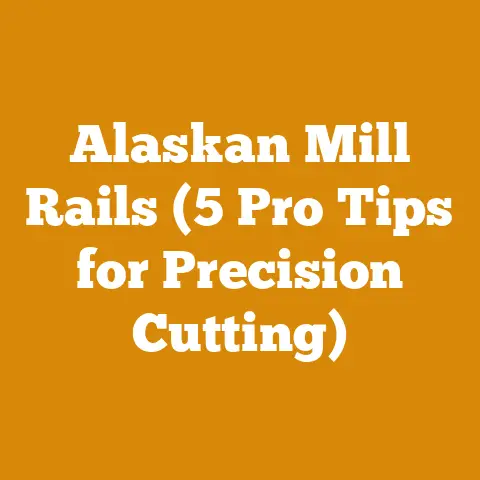Dump Truck Bed Upgrades for Wood Hauling (Pro Tips for Arborists)
Alright, let’s dive into the world of dump truck bed upgrades for wood hauling!
Embracing Green Hauling: Eco-Friendly Dump Truck Bed Upgrades for Arborists
In today’s world, where sustainability is more than just a buzzword, even the burly business of wood hauling needs a green makeover. I’ve seen firsthand how arborists and loggers are increasingly conscious of their environmental footprint. From reducing emissions to minimizing ground disturbance, every little bit counts. So, before we get into the nitty-gritty of dump truck bed upgrades, let’s touch on some eco-friendly options that can make a real difference.
One of the most impactful changes you can make is optimizing your truck’s fuel efficiency. This doesn’t necessarily mean trading in your dependable workhorse for a hybrid (though, wouldn’t that be something?). Instead, consider aerodynamic upgrades for your dump truck bed. These can range from simple bed covers to more sophisticated designs that reduce wind resistance, ultimately saving fuel and lowering emissions.
Another area to consider is the material you use for your bed liner. Traditional steel liners can be heavy, increasing fuel consumption. Lightweight alternatives, such as recycled plastic or composite materials, offer similar durability with a fraction of the weight. Plus, they often require less maintenance and are more resistant to corrosion.
Finally, think about the impact of your hauling practices. Avoid overloading your truck, as this not only increases fuel consumption but also puts undue stress on the vehicle and the environment. Plan your routes efficiently to minimize travel distance and consider using alternative fuels like biodiesel or propane if available in your area.
Now that we’ve touched on the eco-friendly aspects, let’s get down to the real meat and potatoes: upgrading your dump truck bed for optimal wood hauling. I’ve spent years in the field, from small-scale firewood operations to assisting in larger logging projects. Through it all, I’ve learned that a well-equipped dump truck can be the difference between a smooth operation and a logistical nightmare.
Dump Truck Bed Upgrades for Wood Hauling: Pro Tips for Arborists
As an arborist or anyone involved in wood processing, you know that a reliable dump truck is essential. But a well-equipped dump truck? That’s a game-changer. It’s the difference between making a day’s work feel like a breeze and feeling like you’ve wrestled a bear all day. I’ve been there, done that, and learned a few things along the way.
It might be fine for gravel or sand, but logs, branches, and wood chips demand more. Here’s why upgrading is a worthwhile investment:
- Increased Efficiency: A properly upgraded bed can streamline loading and unloading, saving you time and labor.
- Enhanced Safety: Securing loads becomes easier and more reliable, reducing the risk of accidents.
- Improved Durability: Wood can be tough on truck beds, causing dents, scratches, and even structural damage over time. Upgrades can protect your investment.
- Greater Versatility: With the right modifications, you can haul a wider variety of wood products, from logs to mulch.
- Reduced Material Loss: Properly sealed beds minimize the loss of wood chips, sawdust, and other smaller materials during transport.
Key Upgrades to Consider
Now, let’s get into the specifics. Here are some of the most impactful upgrades I’ve found to be beneficial for wood hauling:
Bed Liners: Protection and Efficiency
A bed liner is arguably the most crucial upgrade for any dump truck used for hauling wood. It protects the bed from damage, makes unloading easier, and can even increase the lifespan of your truck.
-
Steel Liners: These are the traditional choice, offering excellent durability and resistance to impact. However, they can be heavy and prone to rust.
- Pros: High durability, good for heavy logs.
- Cons: Heavy, prone to rust, can be expensive.
- Data Point: Steel liners can add up to 1,000 lbs to the truck’s weight, impacting fuel efficiency by 5-10%.
-
Plastic Liners: Lightweight and resistant to corrosion, plastic liners are a popular alternative. They also tend to be more affordable than steel.
-
Pros: Lightweight, corrosion-resistant, affordable.
- Cons: Less durable than steel, can be damaged by sharp objects.
- Data Point: Plastic liners can reduce the truck’s weight by 300-500 lbs compared to steel, improving fuel efficiency.
-
Spray-On Liners: These create a seamless, protective coating that conforms to the shape of the bed. They offer good protection against scratches and dents but may not be as durable as steel or plastic liners for heavy-duty use.
-
Pros: Seamless, conforms to bed shape, good scratch protection.
- Cons: Less durable than steel or plastic, can be expensive to apply.
- Data Point: Spray-on liners typically add 50-100 lbs to the truck’s weight.
-
Rubber Liners: These are great for reducing noise and preventing damage to delicate wood products, such as finished lumber.
-
Pros: Noise reduction, protects delicate materials.
- Cons: Less durable than other options, can be slippery when wet.
My Experience: I once worked on a project where we were hauling freshly milled walnut lumber. The steel bed of the dump truck was causing scratches and dings, which significantly reduced the value of the wood. We switched to a rubber liner, and the problem was solved immediately. It also made the loading and unloading process much quieter, which was a bonus in the residential neighborhood we were working in.
Side Boards and Extensions: Maximizing Capacity
Increasing the height of your dump truck bed with side boards or extensions is a simple yet effective way to boost your hauling capacity.
-
Wood Side Boards: A cost-effective option, but require regular maintenance and are susceptible to rot and damage.
- Pros: Affordable, easy to install.
- Cons: Susceptible to rot, require regular maintenance.
-
Steel Side Boards: More durable than wood, but also heavier and more expensive.
-
Pros: Durable, long-lasting.
- Cons: Heavy, more expensive than wood.
-
Aluminum Side Boards: A good balance of durability and weight, aluminum side boards are a popular choice for many arborists.
-
Pros: Lightweight, durable, corrosion-resistant.
- Cons: More expensive than wood or steel.
Tip: When choosing side boards, consider the type of wood you’ll be hauling. For loose materials like wood chips, taller side boards are essential. For larger logs, you may only need minimal extensions to keep them secure.
Case Study: A small firewood business in upstate New York increased their delivery capacity by 30% simply by adding aluminum side boards to their dump truck. This allowed them to make fewer trips, saving time and fuel.
Tailgate Options: Versatility and Ease of Use
The tailgate is another area where upgrades can make a significant difference.
-
Standard Tailgate: The basic hinged tailgate that comes standard on most dump trucks. It’s simple but can be cumbersome to operate, especially when dealing with large logs.
- Pros: Simple, affordable.
- Cons: Can be difficult to operate, limited functionality.
-
Spreader Tailgate: This type of tailgate allows you to control the flow of materials as you dump, making it ideal for spreading wood chips or mulch evenly.
-
Pros: Controlled material flow, good for spreading.
- Cons: More complex mechanism, can be prone to clogging.
-
Barn Door Tailgate: Featuring two swinging doors, this type of tailgate provides a wider opening for easier loading and unloading.
-
Pros: Wide opening, easier loading and unloading.
- Cons: Can be difficult to operate on uneven ground.
-
Hydraulic Tailgate: The ultimate in convenience, a hydraulic tailgate can be opened and closed with the push of a button.
-
Pros: Convenient, easy to operate.
- Cons: Expensive, requires hydraulic system.
My Insight: I once worked with a crew that used a standard tailgate for hauling firewood. Every time we unloaded, someone had to manually lift the heavy tailgate, which was both time-consuming and physically demanding. We switched to a barn door tailgate, and it made a world of difference. The wider opening allowed us to unload much faster, and it eliminated the need for manual lifting.
Load Securing Systems: Safety First
Securing your load is paramount, not just for safety but also to comply with regulations. Here are some essential load securing systems to consider:
-
Tie-Down Straps: Heavy-duty straps with ratchets or cam buckles for securing logs and other large items.
- Pros: Affordable, versatile.
- Cons: Require manual tightening, can loosen over time.
- Safety Standard: DOT regulations require tie-down straps to have a working load limit that is at least one-third of the weight of the cargo being secured.
-
Chains and Binders: For extremely heavy loads, chains and binders offer superior strength and security.
-
Pros: High strength, durable.
- Cons: Heavy, can be difficult to use, require specialized training.
- Safety Standard: Chains should be inspected regularly for wear and damage, and replaced as needed.
-
Cargo Nets: Ideal for securing loose materials like wood chips and mulch.
-
Pros: Easy to use, good for loose materials.
- Cons: Less effective for large items, can be damaged by sharp objects.
-
Load Binders: Mechanical devices used to tighten chains, ensuring a secure hold on the load.
-
Pros: Provide high tension, secure hold.
- Cons: Can be dangerous if not used properly, require training.
Personal Story: I witnessed a near-disaster when a load of logs shifted during transport because the tie-down straps weren’t properly secured. Thankfully, the driver was able to pull over safely, but it was a stark reminder of the importance of using high-quality load securing systems and ensuring they are properly tightened.
Hydraulic Systems: Power and Control
Upgrading your dump truck’s hydraulic system can significantly improve its performance and versatility.
-
Electric Hydraulic Pumps: A cost-effective option for smaller dump trucks, electric pumps are easy to install and operate.
- Pros: Affordable, easy to install.
- Cons: Less powerful than PTO pumps, can drain battery.
-
PTO (Power Take-Off) Hydraulic Pumps: Driven by the truck’s engine, PTO pumps offer greater power and reliability.
-
Pros: High power, reliable.
- Cons: More expensive than electric pumps, require professional installation.
-
Wireless Remote Control: Allows you to operate the dump bed from a distance, improving safety and convenience.
-
Pros: Convenient, improves safety.
- Cons: Can be expensive, requires installation.
Technical Detail: PTO hydraulic pumps typically provide flow rates of 10-20 gallons per minute (GPM) and pressures of 2,500-3,500 PSI, while electric pumps usually offer lower flow rates and pressures.
Lighting and Visibility: Seeing is Believing
Adequate lighting is essential for safe operation, especially during dawn, dusk, or nighttime hours.
-
LED Work Lights: Bright and energy-efficient, LED work lights provide excellent illumination for loading and unloading.
- Pros: Bright, energy-efficient, long-lasting.
- Cons: Can be expensive.
-
Strobe Lights: Increase visibility in low-light conditions, improving safety on the road.
-
Pros: Highly visible, improves safety.
- Cons: Can be distracting to other drivers.
-
Backup Camera: Provides a clear view of the area behind the truck, reducing the risk of accidents when backing up.
-
Pros: Improves safety, reduces accidents.
- Cons: Can be expensive, requires installation.
Safety Tip: Ensure that all lighting is properly wired and protected from damage. Regularly inspect lights to ensure they are functioning correctly.
Suspension Upgrades: A Smoother Ride
If you frequently haul heavy loads, upgrading your truck’s suspension can improve ride quality, handling, and overall safety.
-
Air Suspension: Provides a smooth, comfortable ride, even when hauling heavy loads.
- Pros: Smooth ride, adjustable height.
- Cons: Expensive, requires installation.
-
Helper Springs: Add extra support to your existing suspension, increasing load capacity.
-
Pros: Affordable, easy to install.
- Cons: Less effective than air suspension.
-
Heavy-Duty Shocks: Improve handling and stability, especially when hauling heavy loads on rough terrain.
-
Pros: Improves handling, affordable.
- Cons: May not provide as much improvement as air suspension.
Data Point: Air suspension systems can reduce vibration and shock by up to 50%, improving driver comfort and reducing wear and tear on the truck.
Choosing the Right Upgrades: A Step-by-Step Guide
With so many options available, choosing the right upgrades for your dump truck can feel overwhelming. Here’s a step-by-step guide to help you make the best decisions:
- Assess Your Needs: What type of wood will you be hauling? How often will you be using the truck? What are your biggest challenges with your current setup?
- Set a Budget: Determine how much you’re willing to spend on upgrades. This will help you narrow down your options.
- Prioritize: Focus on the upgrades that will have the biggest impact on your efficiency, safety, and durability.
- Research: Read reviews, compare prices, and talk to other arborists or loggers to get their recommendations.
- Consult a Professional: If you’re unsure about which upgrades are right for you, consult with a truck mechanic or upfitter.
- Installation: Some upgrades, like bed liners and side boards, can be installed yourself. Others, like hydraulic systems and suspension upgrades, may require professional installation.
- Maintenance: Regularly inspect and maintain your upgrades to ensure they are functioning properly and to extend their lifespan.
Real-World Examples: Success Stories from the Field
Let’s take a look at some real-world examples of how dump truck bed upgrades have helped arborists and loggers improve their operations:
-
Example 1: The Firewood Delivery Service
- Challenge: A small firewood delivery service was struggling to keep up with demand due to inefficient loading and unloading.
- Solution: They installed a barn door tailgate, aluminum side boards, and a spreader tailgate.
- Results: They increased their delivery capacity by 40% and reduced loading and unloading time by 50%.
- Equipment Used: Barn door tailgate, aluminum side boards, spreader tailgate.
- Wood Types: Mixed hardwoods.
- Safety Considerations: Ensured side boards were securely attached and load was properly balanced.
-
Example 2: The Tree Removal Company
-
Challenge: A tree removal company was constantly dealing with damage to their dump truck bed from falling logs and branches.
- Solution: They installed a steel bed liner and reinforced the side walls with steel plating.
- Results: They eliminated damage to the bed and extended the lifespan of the truck.
- Equipment Used: Steel bed liner, steel plating.
- Wood Types: Various tree species.
- Safety Considerations: Used heavy-duty straps to secure logs during transport.
-
Example 3: The Logging Operation
-
Challenge: A logging operation was experiencing high fuel costs due to the weight of their dump trucks.
Here are a few common pitfalls to avoid:- Choosing the Wrong Liner: Selecting a liner that isn’t durable enough for the type of wood you’re hauling.
- Overloading the Truck: Exceeding the truck’s weight capacity can damage the suspension and brakes, and it’s illegal.
- Neglecting Load Securing: Failing to properly secure your load can lead to accidents and fines.
- Ignoring Maintenance: Neglecting to maintain your upgrades can shorten their lifespan and reduce their effectiveness.
- DIY Disasters: Attempting to install complex upgrades without the proper knowledge or tools can lead to costly mistakes.
The Future of Wood Hauling: Innovations on the Horizon
The world of wood hauling is constantly evolving, with new technologies and innovations emerging all the time. Here are a few trends to watch out for:
- Electric Dump Trucks: As electric vehicle technology improves, we’re likely to see more electric dump trucks on the road. These trucks offer zero emissions and lower operating costs.
- Autonomous Dump Trucks: Self-driving dump trucks could revolutionize the logging industry, improving efficiency and safety.
- Smart Load Securing Systems: Automated load securing systems that use sensors to monitor tension and adjust as needed.
- Lightweight Materials: New lightweight materials, such as carbon fiber composites, could further reduce the weight of dump truck beds, improving fuel efficiency.
Final Thoughts: Investing in Your Success
Upgrading your dump truck bed for wood hauling is an investment in your success. By choosing the right upgrades and maintaining them properly, you can improve efficiency, enhance safety, and extend the lifespan of your truck. So, take the time to assess your needs, do your research, and invest in the upgrades that will help you get the job done right. After all, a well-equipped dump truck is a wood hauler’s best friend. And remember to always prioritize safety and sustainability in your operations.






